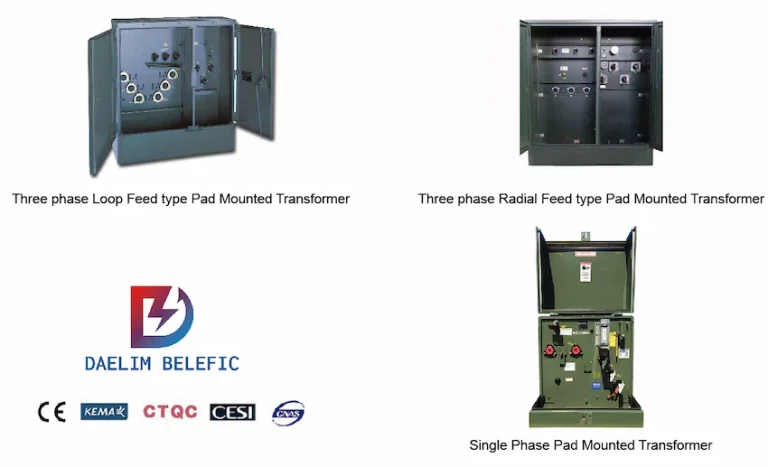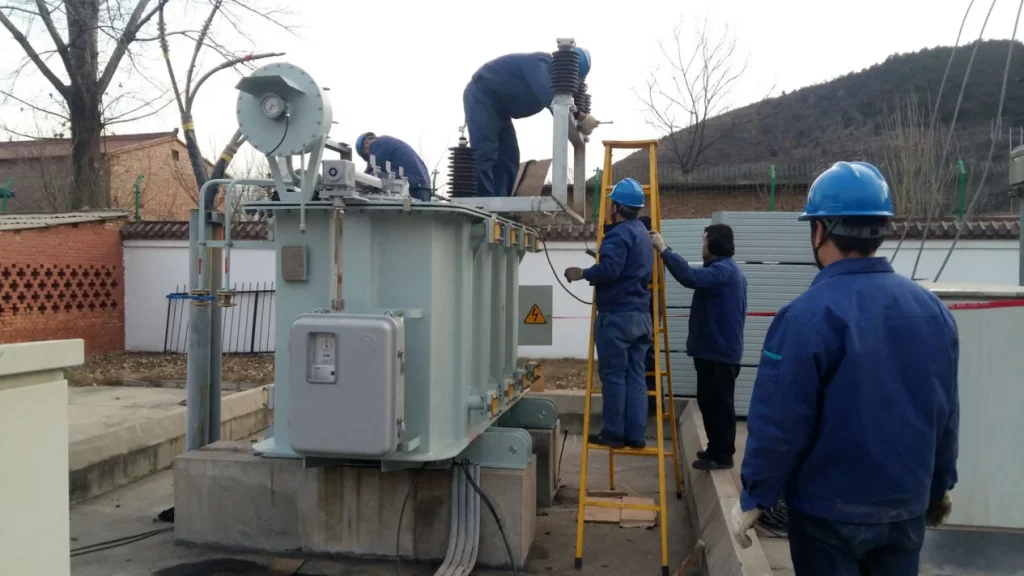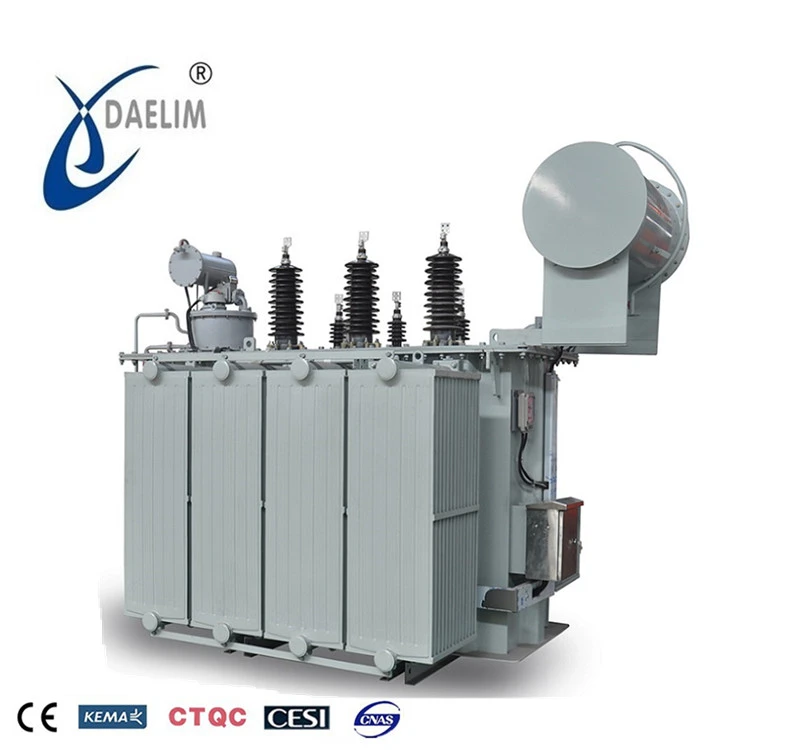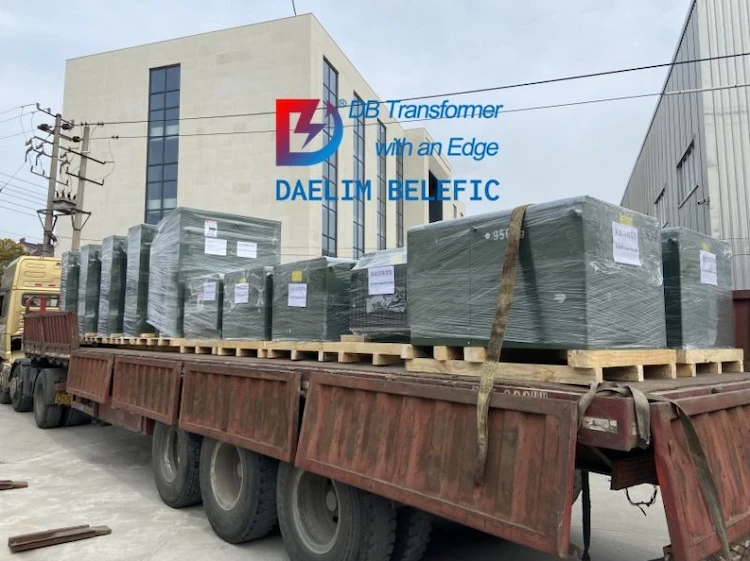ELECTRIC, WITH AN EDGE
Power distribution involves the transmission and transformation of electricity in different voltage levels. Transformers play a crucial role in power distribution from power plants of high voltage levels to households of lower voltage levels.
Distribution transformers are specifically the transformer type necessary for this distribution of power. Under normal circumstances, distribution transformers involve medium ranges of voltages.
Most of these transformer types are referred to as medium voltage transformers, and that’s the topic of this article. Here, you learn about the importance and all relevant information about medium voltage transformers.
Now, if you are looking for medium voltage transformers and similar electrical products, you better make a note of DAELIM. Jiangsu Daelim Electric Co. Ltd launched their transformer brand to answer the ever-changing market demands for high-quality transformers.
Daelim Belefic is synonymous with excellence and cost-efficiency and has been a renowned product for over 15 years. The company makes its products under compliance with ANSI, IEEE, CSA, and IEC standards.
-FIND THE BEST THREE-PHASE COMBINED POWER TRANSFORMER GUIDE ON THE WEB ALL IN ONE PLACE. SEE OUR LIST OF 8+FAQ RIGHT HERE.
-IEC 60076-24:Specification of voltage regulating power distribution transformers (VRDT) . Daelim has produced the power transformer since 1996.
-A lot of electrical companies use high voltage Distribution transformer to effectively operate at applications that are at high voltage levels.
Medium voltage transformers are transformers operating in the voltage range of 2 kV to 35 kV. This voltage range is common for the distribution transformers, which generally classify them as medium voltage types.
The medium-voltage distribution transformers are responsible for stepping down electricity in usable customer ratings. It provides final voltage transformation, which defines it as the final gateway for energy distribution.
Typically, several homes can be connected to one distribution transformer. However, there are cases wherein customers request a much larger amount of power. In this scenario, they may connect directly to the distribution level or on sources designated by the power provider.
Customers with special requirements can connect to the secondary distribution lines through service drops or by bi-directional transmission.
A medium voltage transformer is a type of electrical transformer designed to step up or step down the voltage of an electrical power supply in the range of 1 kV to 72.5 kV. These transformers are commonly used in electrical power distribution systems to transfer power between different voltage levels, such as from a substation to a distribution network or from a generator to a transformer.
Medium voltage transformers are typically larger in size and capacity than low voltage transformers, and they are designed to withstand higher voltage and current levels. They are often used in industrial applications, such as manufacturing plants and large commercial buildings, as well as in power transmission and distribution systems.
Medium voltage transformers can be designed for different types of loads, including resistive, inductive, or capacitive loads, and they can be constructed using different types of insulation, such as oil-immersed or dry-type insulation. They can also be designed for indoor or outdoor installation, depending on the application requirements.
Overall, medium voltage transformers play a critical role in the distribution and transmission of electrical power, helping to ensure that power is delivered safely and reliably to end-users.
As aforementioned, the standard range of medium voltage transformers is around 2 kV to 35 kV.
However, transformer sizing comes in a different unit which is kVA.
The kVA unit represents kilovolt-amperes or 1,000 volt-ampere ratings.
It is the amount of voltage multiplied by the current in amperes.
For example, a transformer with a 1.0 kVA rating implies it can handle 100 volts at 10 amps of current.
Manufacturers can have varying transformer sizes that they distribute.
It is typical to have a 75–5,000 kVA range concerning the range for medium voltage transformers.
For specificity, it is imperative to consult with your manufacturer or supplier which rating applies best to your application.
The pad-mounted transformer is a ground-installed distribution transformer encased in a metal cabinet atop a small concrete pad.
These are distribution transformer types prominent among residential subdivisions and are power-efficient, tamper-resistant, and compact.
They are ideal for applications where public safety is paramount.
The pad-mounted transformers can either be a single-phase or three-phase system.
Depending on this phase design, it can cater to varying amounts of loads.
Three-phase pad-mounted transformers offer higher load capacities and are typically oil-submerged.
This same regard in the cooling mechanism is a consideration as oil contents can be hazardous if mismanaged.
Manufacturers typically produce pad-mounted transformers within the range of 75 to around 5000 kVa.
In many cases, the transformer package includes safety switches and built-in fuses.
Furthermore, like many distribution transformer types, this type can also cater to numerous service lines or households.
A typical pad-mounted transformer set comprises the core/coil assembly (including the transformer) immersed in oil or the like.
Additionally, a wiring cabinet with high and low-voltage wiring compartments encloses high and low-voltage bushings, respectively.
It is also typical to weld the cover to prevent unauthorized access to the enclosure.

Another medium-voltage transformer type is the pole-mounted transformer.
This type might be the most publicly familiar as it is the cylindrical component mounted on a power pole.
You can also say that pole-mounted transformers are the overhead counterpart of pad-mounted transformers but are more common in remote areas.
Pole-mounted transformer rating can range from 16 kVA to 100kVA. Like all transformer types, it can either be a single or three-phase design.
Although most pole-mounted transformers are single-phase, three-phase designs can have significant advantages.
Among these advantages, the most notable is that three-phase types can be cleanly installed and more efficient.
Furthermore, manufacturers design these transformer’s cases to reduce the accumulation of water and corrosive materials, ideal for harsh environments.
They are also better at handling high voltages than standard transformers.

This transformer is the substation’s core and regulates the voltage coming out of the power generation.
Typically, you can rate these transformers through their input and output voltage relationships.
A typical rating includes 15 kV, 25 kV, or 35 kV on the primary at a power rating of about 5-20 MVA.
In addition, its secondary voltage can come around 15 kV or even less than 600 V.
As typical for higher ratings, substation transformers are usually oil-submerged.
This oil content serves as a temperature regulator that keeps the device working even at extremely high loads.
Other common features among distribution transformers are fins for oil circulation and heat dissipation.
Other models have fans or pumps to circulate oil forcibly.
Medium-voltage transformer clearances can vary per type.
The local building department establishes transformer spacing guidelines for a transformer located near a building or structure.
For pad-mounted transformers, the typical clearance requires up to 4ft minimum vertical clearance assuming no windows are within the vicinity.
Furthermore, the sides of the unit must be clear for a minimum of 3ft.
Also, the transformer needs to be 10ft horizontally far from building fenestrations and fire hydrants.
Meanwhile, pole-mounted transformers should be 5 meters high from the ground level and mounted on designated locations.
Lastly, for substation transformers, it is the local energy regulating bodies that assign the clearances.
However, the common standard is for it to be enclosed in a fenced and secured compound.
It also requires the necessary provision for safety controls and checks.
There are different types of medium voltage transformers available in the market. Some of the common types include:
Dry-type transformers: These transformers use air as a cooling medium instead of oil. They are typically used in indoor applications where flammable liquids cannot be used.
Oil-immersed transformers: These transformers use oil as a cooling and insulating medium. They are commonly used in outdoor applications where higher power ratings are required.
Pad-mounted transformers: These transformers are mounted on a concrete pad and are used for underground power distribution.
Cast resin transformers: These transformers use epoxy resin as an insulating material. They are typically used in indoor applications where fire safety is a concern.
Autotransformers: These transformers have a single winding that serves as both the primary and secondary winding. They are commonly used for voltage regulation and can be more cost-effective than traditional transformers.
Instrument transformers: These transformers are used for metering and protection purposes. They include current transformers (CTs) and voltage transformers (VTs).
The type of transformer selected depends on the specific application requirements, such as voltage rating, power rating, environmental factors, and safety considerations. Consulting with a qualified transformer manufacturer can help determine the best type of transformer for a specific application.
Transformer manufacturers can designate different transformer sizes, both for convenience and asset standards.
However, in terms of common market options, here are the corresponding standard sizes:
To get the specific ratings that you need, do consult with your manufacturer. A set of specifications is a standard for full product information.
The specifications of medium voltage transformers may vary depending on the specific application and requirements of the customer. Here are some common specifications that may be considered:
Voltage rating: Medium voltage transformers typically have a voltage rating between 1 kV and 72 kV. The voltage rating determines the maximum voltage that the transformer can handle without breaking down.
Power rating: The power rating of a transformer is measured in kilovolt-amperes (kVA) or megavolt-amperes (MVA) and indicates the maximum amount of power that the transformer can handle.
Frequency: The frequency of the electrical system determines the frequency of the transformer. Common frequencies are 50 Hz or 60 Hz.
Cooling method: Transformers generate heat during operation, so it is important to have a cooling system to prevent overheating. Medium voltage transformers can be cooled by air or oil.
Efficiency: The efficiency of a transformer is measured as the ratio of output power to input power. Higher efficiency transformers can save energy and reduce operating costs.
Size and weight: The size and weight of the transformer may be important considerations, especially if space is limited or if the transformer needs to be transported to a remote location.
Insulation class: The insulation class of a transformer indicates the maximum temperature that the transformer can handle. The insulation class is typically designated by a letter, such as A, B, F, or H.
Noise level: Transformers can generate noise during operation, so it may be important to specify a maximum allowable noise level.
By considering these specifications, customers can select a medium voltage transformer that meets their specific needs and requirements.
The population uses mains electricity to power machines and appliances in homes and businesses in many parts of the world.
It is delivered by AC power lines, which run through buildings or run underground.
Voltage and frequency are different in every region. In the United States, a voltage of 120 V and a frequency of 60 Hz is used.
In other parts of the world, they use a voltage of 230 V and a frequency of 50 Hz.
Also, note that a different combination can exist, like 230 V at 60 Hz.
Medium voltage transformers are probably the most widespread range type of transformers.
After all, these transformers are responsible mostly for power distribution and are directly proportional to the population density.
Aside from being widely distributed, it is also a device that requires high-need for efficiency and reliability.
Thus, it is imperative to find a trusted name in selecting medium voltage transformers.
In this regard, DAELIM is among the top transformer manufacturers.
After building a reputation in the Chinese market, DAELIM continues to establish itself as among the resounding names in the electric market globally.
With its high regard for quality, Daelim developed Daelim Belefic, a transformer brand that is both competent and cost-efficient.
Daelim Belefic is your partner for electrical solutions and products. For inquiries, contact DAELIM today.
20 kv Voltage transformer vs 10 kv Voltage transformer

The rating of a medium voltage transformer refers to the maximum power that the transformer can handle without overheating or causing damage to the equipment. The rating of a transformer is usually expressed in kVA (kilovolt-amperes) or MVA (megavolt-amperes).
Medium voltage transformers typically have ratings ranging from a few kVA to several MVA, depending on their application and usage. The rating of a transformer is determined by various factors such as the voltage level, load requirements, and efficiency of the equipment.
The rating of a medium voltage transformer is also influenced by the cooling method used in the transformer. For instance, a transformer that uses oil-immersed cooling will have a higher rating than an air-cooled transformer of the same size.
It is important to note that the rating of a transformer should not be exceeded, as this can result in equipment failure, overheating, and damage to the transformer or other connected equipment. Therefore, it is crucial to select the appropriate transformer rating based on the load requirements and other specifications of the system.
When selecting a medium voltage transformer, it is important to consider factors such as the expected load, the ambient temperature, the type of cooling system, and other specific requirements of the application. Consulting with a qualified engineer or transformer manufacturer can help ensure that the right transformer rating is selected for the specific application.
Medium voltage transformers come in a variety of sizes, depending on their intended use and application. They can range in size from small units that are designed for use in residential or commercial settings to larger transformers that are used in industrial applications.
The size of a medium voltage transformer is usually determined by its power rating, which is measured in kilovolt-amperes (kVA) or megavolt-amperes (MVA). A transformer’s power rating is determined by the maximum amount of power it can deliver to a load without exceeding its temperature limit.
Medium voltage transformers are available in various standard sizes and ratings, with typical ratings ranging from a few kVA to several MVA. The specific size and rating of a transformer will depend on its intended use and application, as well as the requirements of the local power grid.
Some common sizes of medium voltage transformers include 15 kVA, 30 kVA, 45 kVA, 75 kVA, 112.5 kVA, 150 kVA, 225 kVA, 300 kVA, 500 kVA, 750 kVA, 1000 kVA, and 1500 kVA. However, manufacturers can also provide customized solutions to meet the specific requirements of their customers.
When selecting a medium voltage transformer, it is important to consider the available space for installation, the power requirements of the load, and the voltage levels of the local power grid. A transformer that is too small for the load can result in overload and damage to the transformer, while a transformer that is too large can lead to inefficiencies and unnecessary costs.


There are many manufacturers of medium voltage transformers, including:
Daelim Belefic
ABB
Siemens
Schneider Electric
GE
Eaton
Each manufacturer has its own unique strengths and expertise, and customers should consider factors such as product quality, reliability, and after-sales service when selecting a manufacturer. It’s also important to ensure that the manufacturer’s products meet relevant industry standards and regulations, such as IEC and IEEE standards, as well as any local regulations and requirements.
A medium voltage transformer sizing chart is a tool that helps to determine the appropriate size or capacity of a transformer for a specific application based on various parameters. These parameters may include the voltage rating, current capacity, and power rating of the system, as well as factors such as load type, ambient temperature, and altitude.
The sizing chart typically presents the required transformer capacity in kVA (kilovolt-ampere) based on the input parameters. For example, a chart may list the required kVA rating based on the primary voltage, secondary voltage, and expected load current.
It is important to use a reliable and accurate sizing chart, as selecting an undersized transformer can result in poor performance and premature failure, while selecting an oversized transformer can lead to unnecessary costs and inefficiencies.
Most transformer manufacturers provide sizing charts or tools to help customers select the appropriate transformer size for their application. These tools may be available online or through the manufacturer’s customer service department. It is recommended to consult with a qualified engineer or electrician when selecting a transformer to ensure proper sizing and installation.
Medium voltage transformer protection refers to the methods and devices used to protect a medium voltage transformer from damage and failure caused by electrical faults or overloading.
Medium voltage transformers can be protected by a combination of protective devices, including fuses, circuit breakers, relays, and transformers. These protective devices are designed to detect and isolate faults in the electrical system to prevent them from reaching the transformer.
The protection system for a medium voltage transformer is designed based on the transformer’s specifications, ratings, and the electrical system in which it is installed. This includes considering factors such as the transformer’s voltage rating, current rating, impedance, and its position within the electrical system.
Common protection methods for medium voltage transformers include overcurrent protection, differential protection, and overvoltage protection. Overcurrent protection is typically achieved using fuses or circuit breakers, while differential protection is accomplished by comparing the currents on the primary and secondary windings of the transformer. Overvoltage protection is achieved by using surge arresters, which protect the transformer from damage caused by high-voltage surges.
Overall, proper medium voltage transformer protection is crucial to ensure the safe and reliable operation of the transformer and the electrical system in which it is installed. It helps to prevent transformer failure, prolong its lifespan, and minimize downtime and associated costs.
When you need to find more than just existing transformers, Daelim’s Transformer Service Center can help you design and produce distribution transformers that meet your unique needs.
We have our own factory and a professional team of engineers, which can design and modify application requirements that meet all your conditions.
Download Resource
ELECTRIC, WITH AN ENGE-- DAELIM BELEFIC
After filling in the contact information, you can download the PDF.